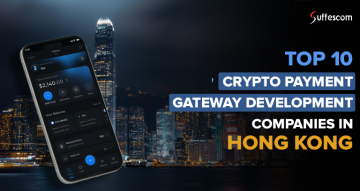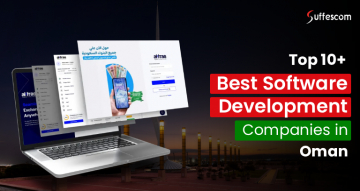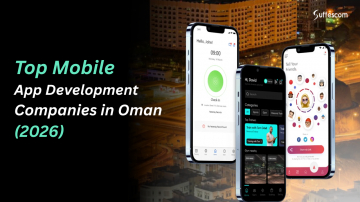Ecommerce App Development Cost in Saudi Arabia 2025

Today, ecommerce apps are emerging as an essential component in Saudi Arabia as it is accelerating toward digital evolution. Guided by Vision 2030, the growing use of smartphones and a technology-oriented population, companies are starting to invest more in ecommerce solutions adapted to the Saudi market.
So, are you planning to start an ecommerce application in Saudi Arabia 2025? Then you must understand the dynamics of the cost. In this blog, we have streamlined all the factors that are considered in ecommerce app development cost, including the duration, the cost affecting factors, and effective budgeting tips, so that you make the appropriate choices and have an end product that is highly performing and can capture the KSA market within the shortest time possible.
Overview of the Ecommerce Boom in Saudi Arabia (2025 Outlook)
In Saudi Arabia, the ecommerce industry is undergoing a speedy change in 2025. Visionary government projects, mass digitalisation, and a change in the behavioural pattern toward preferring mobile-first experiences stimulate this growth. Ecommerce apps have become more than just an option for businesses that seek to succeed in the competitive business environment. A combination of innovation, infrastructure investment, and a young population with enthusiasm for digital shopping is shaping the landscape.
KSA Vision 2030 and Its Role in Ecommerce Growth
- Saudi Arabia Vision 2030 is one of the major catalysts of the digital transformation of the country that embraces ecommerce as a national strategy for growth.
- To cultivate the digital economy, the investments by the government are directed towards smart cities, futuristic internet infrastructure, and innovation hubs.
- The ambition is to lessen the reliance on oil and give strength to the private sector, particularly the technological and electronic commerce domains.
- Initiatives like the National Digital Transformation Program are enabling startups with:
-Mentorship and business development training
-Regulatory support and streamlined licensing
-Access to capital and partnerships with tech accelerators
- Ecommerce businesses are benefiting from relaxed regulations, easier access to funding, and government-backed digital infrastructure.
Digital Adoption and Mobile-First User Behaviour in Saudi Arabia
- Saudi Arabia has one of the highest smartphone penetration rates globally, exceeding 98%.
- Consumers love transacting through mobile devices to shop, bank, and carry out their daily transactions.
- The demand of younger users is for fast, responsive, and immersive mobile experiences, which drives the need:
-Lightning-fast app performance
-Seamless navigation and intuitive UI
-Mobile-first design and UX optimisation
- Companies that aim to attract the Saudi audience should focus on mobile commerce and in-app engagement.
Saudi Ecommerce Revenue & Market Size 2025
- The ecommerce market in Saudi Arabia is forecasted to surpass $16.53 billion in revenue by the end of 2025.
- Key sectors experiencing strong ecommerce growth include:
-Fashion and Apparel
-Electronics and Gadgets
-Beauty and Skincare
-Grocery and Household Essentials
- Online sales are outpacing traditional retail due to:
-Faster, more reliable logistics infrastructure
-Trusted and secure local payment options
-Rising consumer confidence in online shopping platforms
- Leading platforms like Noon and emerging local players are expanding aggressively across the Kingdom.
- The competition between global and local brands is opening new opportunities for innovation, niche markets, and localised app solutions.
What Influences Ecommerce App Development Costs in Saudi Arabia
When intending to develop an e-commerce application in Saudi Arabia, it is very important to comprehend the various aspects that determine the total e-commerce app development cost. These do not merely consist of technical specifications; the factors also incorporate cultural, regulatory, and business considerations that are peculiar to the Kingdom. An educated budget plan begins by understanding what influences cost at every level of development.
Key Factors That Influence The Cost

App Complexity
The more complicated the ecommerce app is, the more expensive it will be.
- Simple ecommerce apps typically have a very basic set of features. These are best for small retailers or niche businesses.
- Mid-level ecommerce apps encompass enhanced functionalities. These apps offer better user engagement and customer retention than basic ecommerce apps.
- Complex ecommerce apps may include various integrations and modules with the latest technologies. These solutions are tailored for large-scale operations or marketplace models.
Each added functionality means more development hours, testing cycles, and quality assurance steps, which ultimately increases the ecommerce app development cost Saudi Arabia.
Platform Type (iOS, Android, Web, or Hybrid)
The platform or platforms that you select will have a direct impact on the cost of development.
- Native apps are developed either on iOS (Swift) or Android (Kotlin) specifically. They offer the best performance and user experience, but they need to be developed and maintained twice as long and expensively as two codebases.
- Cross-platform applications, including those created with Flutter or React Native, enable one codebase to execute on both iOS and Android. It is usually a cheaper method, particularly for startups or SMEs.
- Web dashboards and progressive web apps (PWAs) can also be necessary, in particular, in the case of admin users or B2B ecommerce needs. These introduce additional levels to the development and hosting specifications.
The appropriate choice depends on your business objectives, target, and future scalability.
UI and UX Design Preferences
Design plays a vital role in user retention and brand perception, especially in the competitive Saudi ecommerce space.
- Culturally appropriate design that reflects regional aesthetics, values, and shopping habits is essential. This often includes elegant typography, subtle animation, and visual clarity.
- Arabic language support requires designing for right-to-left orientation. This affects alignment, icons, and navigation structure. Designing the UI twice, once for Arabic and once for English, adds effort and cost.
- Personalised experiences like dark mode, customisable themes, or interactive product displays enhance user satisfaction but also require more development hours.
A compelling, responsive design ensures higher user engagement and conversion rates, but it will increase the design and frontend development cost.
Custom Features
Each additional feature increases the app’s scope and cost. Custom functionalities tailored to Saudi shopping behaviours provide a competitive advantage but require extra development time.
- Live chat and AI-based support systems make customer service better by reducing drop-off rates.
- Augmented Reality (AR) permits consumers to visualise products in real life before purchase.
- Advanced filtering and sorting help users navigate large product catalogues easily.
- Integration with delivery platforms such as Aramex, SMSA Express, and Naqel improves last-mile logistics.
- Push notifications and loyalty programs drive user retention and boost repeat sales.
Each of these features must be carefully planned, tested, and optimized across platforms, which increases both development and post-launch maintenance costs.
Developer Expertise and Location
Who builds your app plays a major role in determining the total ecommerce app development cost Saudi Arabia:
- Top app development companies are more expensive but offer region-specific expertise, easy collaboration, and compliance issuance. They also understand cultural nuances and legal frameworks better.
- An offshore ecommerce app development company in countries like Egypt and India offers cost advantages and a larger talent pool. However, they may require detailed documentation, strong project management, and timezone coordination.
- Hybrid models involve core development offshore, but project oversight and compliance are handled by a local agency. This balances quality and cost.
Choosing the right partner depends on your budget, timeline, and need for cultural alignment.
Regulatory and Cultural Considerations in Saudi Arabia
Launching a profitable ecommerce application in Saudi Arabia also implies compliance with the laws, user choices, and technology infrastructure in the country. These are very important aspects that can affect the time scale and the expenditure of your ecommerce app development.
Bilingual Language Support
- Ecommerce apps in Saudi Arabia are expected to offer both Arabic and English language options. This ensures accessibility for all users and aligns with national inclusivity goals.
- Supporting right-to-left direction means involving UI engineering, especially for navigation, product pages, checkout forms, and dynamic content.
- Every section of the app, from button labels to error messages, must be properly installed and tested for both languages. This requires more cost and skilled localization with the best quality assurance teams.
Local Payment Gateway Integration
- Localised payment systems like Mada, STC Pay, HyperPay, and Apple Pay are preferred by Saudi users for their familiarity and security.
- These integrations must meet CITC regulations and offer secure, encrypted transaction flows.
- App developers must also accommodate multi-currency support, VAT calculations, and refund policies specific to the region’s ecommerce laws.
Integrating these gateways is not just a technical task but also a legal and financial responsibility that adds to the overall ecommerce app development cost Saudi Arab.
Compliance with KSA Regulations
- Apps must comply with Saudi ecommerce law and CITC cybersecurity standards, which include storing sensitive user data within the region.
- Failure to comply can lead to hefty fines, app removal, or denial of business licenses.
- You may also need to obtain commercial registration, digital product licensing, and content approvals before launching
Ensuring legal compliance often involves working with legal consultants, local hosting providers, and regulatory authorities, which adds to project scope and expenses.
Steps to Building a Successful Ecommerce App in Saudi Arabia
Creating an e-commerce app is not merely a coding process, but a process of matching business objectives with market expectations and user experience. The important steps are as follows:
Define Your Business Model:
- Choose between a single-vendor, multi-vendor, or niche-focused ecommerce app.
- Identify your target audience and localize based on Saudi Arabia's buying behaviour.
- Decide on revenue streams like commissions, subscriptions, or feature listings.
Research Market and User Needs
- Analyze competitors to distinguish your app from them.
- Understand Saudi user preferences for design, checkout experience, and delivery.
- Conduct surveys and interviews to validate your concept.
Choose the Right Tech Stack
- Use Flutter or React Native for cross-platform development.
- Opt for Node.js and Django for scalable backends.
- For the database, use PostgreSQL and MongoDB.
- For cloud hosting, use AWS or Google Cloud.
Design the UI/UX
- Support RTL layouts and real-time language switching.
- Use regionally appropriate color schemes and iconography.
- Optimize for mobile-first behavior with fast loading speeds and clean navigation.
Develop the App in Iterations (Agile Approach)
- Start with an MVP focusing on core features.
- Test and collect feedback from real users.
- Gradually add features like loyalty programs, analytics, and AR.
Test Thoroughly Before Launch
- Perform functional, usability, and security testing across devices.
- Ensure smooth bilingual support and RTL rendering.
- Simulate local payment and shipping flows to avoid post-launch issues.
Deploy and Launch the Ecommerce App
- Launch the App on iOS and Android with bilingual support.
- Run Launch Campaigns on social media and Google Ads.
- Track Performance Metrics and fix early issues fast.
Detailed Ecommerce App Development Cost Breakdown (Saudi Arabia 2025)
As you plan to start your project in Saudi Arabia, it is highly essential to know about the ecommerce app cost 2025 in the region. Below is a detailed analysis based on complexity.
Ecommerce App Cost in Saudi Arabia
| Ecommerce App Complexity | Estimated Timeline | Estimated Development Cost (SAR) |
| Basic | 2 – 3 months | 45,000 SAR – 70,000 SAR |
| Mid-Level | 4 – 6 months | 70,000 SAR – 140,000 SAR |
| Advanced | 6 – 12 months | 150,000 SAR – 300,000+ SAR |
Basic Ecommerce App:
The simplest e-commerce application would range between SAR 45,000 and SAR 70,000, and this would suit startups, small shops, and niche companies making their first steps in the digital environment. It focuses on functionality and reduced design complexity.
Core Features Included
- Product catalogue with basic filtering and categories
- Simple user registration and login
- Shopping cart and checkout process
- Integration with at least one local payment gateway
- Order summary and confirmation
- Basic admin panel for product and order management
Time Required (2 to 3 months)
- Planning and Requirement Gathering: 1 to 2 weeks
- UI/UX Design: 1 to 2 weeks
- Frontend and Backend Development: 4 to 6 weeks
- Testing and QA: 1 to 2 weeks
- Deployment and Launch: 1 week
Ideal For
- For retailers with limited inventory
- When speed-to-market is critical
- Budget-focused ecommerce startups
This cost and timeline covers planning, design, development, testing, and initial deployment. Post-launch maintenance, hosting, and marketing are typically charged separately.
Mid-Level Ecommerce App
Mid-tier ecommerce apps can cost anywhere between SAR 70,000 to SAR 140,000 and are suitable for growing businesses or SMEs aiming to offer a more refined shopping experience with additional features and improved performance.
Core Features Included
All basic features, plus:.
- User Dashboard with order history and saved addresses
- Product Ratings and Customer Reviews
- Wishlist and loyalty programs
- Live chat support or chatbot integration
- Order tracking and notification system
- An advanced admin panel for managing inventory, discounts, and analytics
Time Required (4 to 6 months)
- Product Strategy and Planning: 2 to 3 weeks
- Custom UI/UX Design: 3 to 4 weeks
- App Development: 8 to 12 weeks
- Integrations: 2 to 3 weeks
- Testing, Optimization, and Pre-Launch: 3 to 4 weeks
- Final Launch: 1 week
Ideal For
- For growing businesses or established retail brands
- Apps that expect high engagement and require customer feedback loops
- Businesses targeting KSA’s bilingual, mobile-savvy market
This pricing includes more intensive design, larger development teams, and extra testing phases. It's ideal for businesses with larger customer bases and diverse product categories.
Advanced Ecommerce App
These type of e-commerce apps ranges from 150,000 SAR to 300,000+ SAR and are best suited for large enterprises or businesses launching marketplace platforms, AI-powered shopping apps, or ecommerce portals with cutting-edge technologies.
Core Features Included
All basic and mid-level features, plus:
- Multi-vendor marketplace model with seller dashboards
- AR-based product previews and 3D models
- AI-driven product recommendations and personalisation
- Voice search support in Arabic and English
- Real-time delivery integration with logistics APIs
- Advanced analytics for user behaviour and sales trends
- CRM and ERP integration for business operations
Time Required (6 to 12 months)
- Requirement Analysis and Roadmapping: 3 to 4 weeks
- Design and Prototyping: 4 to 6 weeks
- Core Development: 12 to 20 weeks
- Integrations and Advanced Modules: 4 to 6 weeks
- Testing and Quality Assurance: 4 to 6 weeks
- Beta Launch and Iterations: 2 to 3 weeks
- Final Launch and Support Setup: 1 to 2 weeks
Ideal Use Case
- Multi-brand ecommerce platforms or marketplaces
- Government or enterprise-backed ecommerce projects
- Businesses aiming for innovative features and long-term scalability
This cost range covers advanced architecture, dedicated teams, multi-stage testing, and integration with third-party tools. Ongoing post-launch support, upgrades, and optimization are usually retained through long-term contracts.
Ready to Build Your E-commerce App in Saudi Arabia?
Get in touch with our experts today for a free consultation and a personalized cost estimate.
Hidden Ecommerce App Development Costs You Should Know
While most businesses budget for design, development, and launch, there are additional hidden factors that can highly impact your overall ecommerce app cost 2025. These costs often show up post-launch but are critical for long-term success, scalability, and smooth user experience.
Post Launch Maintenance and Support
Even after your app is live, ongoing support is essential for performance, security, and feature evolution.
- Bug fixes and issue resolutions after the feedback.
- App updates to remain compatible with iOS and Android version changes.
- Security patches to fix vulnerabilities and stay compliant with CITC regulations.
- Feature upgrades based on user behaviour and competitive trends.
- Annual or monthly maintenance contracts for continuous performance monitoring.
Post-launch support typically costs 15% to 25% of the original Saudi Arabia ecommerce development cost annually.
Hosting, Server, And Backend Infrastructure
Every ecommerce app requires a solid backend infrastructure to function reliably and at scale. This includes cloud services, data management, and content delivery.
- Cloud hosting services such as AWS, Azure, or Google Cloud are commonly used for scalability.
- Database hosting and storage for managing user data, inventory, and transactions
- Content Delivery Network (CDN) for faster loading speeds across Saudi regions
- Backup and disaster recovery systems to avoid data loss
Depending on app traffic and storage needs, monthly infrastructure costs can be 10% to 20% of the total Saudi Arabia ecommerce development.
Payment Gateway Setup and Transaction Charges
Payment gateway integration is not just a one-time setup. It involves both technical and financial commitments.
- Initial setup fees for local gateways like STC Pay, Mada, and HyperPay.
- Recurring transaction fees per order are usually between 1.5% and 3%.
- Monthly or annual maintenance charges for payment API access.
- PCI DSS compliance and tokenization for secure payments.
Neglecting to factor in these fees can reduce your profit margins significantly over time.
Third-Party Services and Integrations
Integrating external tools or services to enhance app functionality often comes with separate costs.
- Chat support tools may charge monthly per user.
- Analytics platforms like Mixpanel or Firebase with premium tiers.
- Inventory and warehouse management systems.
- Delivery tracking APIs from local logistics providers.
Most of these are subscription-based and billed monthly or annually.
Popular Tech Stacks Used for Ecommerce Apps
One of the most vital decisions when creating a reliable, scaling, and high-performance ecommerce application in Saudi Arabia is selecting an appropriate tech stack. The choice of technologies has an influence on the rate of development and user experience, all the way to long-term maintainability and the ability to integrate with other systems. Let’s discover the most frequently utilized stacks specific to the Saudi Arabian digital environment.
Frontend Frameworks
The frontend defines how users interact with the app. Choosing a modern, flexible, and responsive framework is key to ensuring a seamless experience.
- Developed by Facebook, ideal for building native-like apps using JavaScript
- Enables faster development for both iOS and Android with a shared codebase
- Strong community support and plugins for ecommerce features
Flutter
- Developed by Google, based on the Dart programming language
- Allows rich UI customization, ideal for Arabic-first and RTL apps
- Excellent performance with built-in widgets for smooth animations
Angular
- A web application framework by Google, great for progressive web apps (PWAs)
- Useful for ecommerce platforms offering a web-based experience alongside mobile apps
- Supports component-based architecture and scalable frontends
Backend Technologies
The backend handles data processing, server-side logic, and integrations. It powers the product catalog, order management, payments, and user profiles.
Node.js
- Non-blocking, fast, and scalable JavaScript runtime
- Perfect for real-time updates like order tracking and chat
- Widely used in ecommerce for high-performance APIs
Laravel
- PHP-based backend framework with MVC architecture
- Ideal for structured development and secure backend operations
- Built-in support for user roles, carts, and payment workflows
Firebase
- Backend-as-a-Service from Google
- Real-time database, analytics, crash reporting, and push notifications
- Best suited for startups needing quick MVPs
Database and Hosting Solutions
Choosing the right storage and hosting option ensures reliability, speed, and data security, especially when complying with local regulations.
AWS (Amazon Web Services)
- Scalable, cloud-based infrastructure used by enterprises and startups alike
- Offers Arabic language support and data centers in the Middle East
- Includes auto-scaling, load balancing, and secure storage solutions
MySQL
- An open-source relational database used widely in ecommerce
- Best suited for structured data like product listings and user accounts
- Easy to integrate with Laravel and other backend frameworks
MongoDB
- NoSQL database is ideal for large-scale unstructured data
- Suitable for storing user activity, chat logs, and product recommendations
- High performance and scalability with flexible schema design
While these technologies are most widely adopted for Ecommerce app development in Saudi Arabia, the final tech stack should always align with your specific business requirements, scalability goals, and user experience expectations.
Key Features for Ecommerce Apps in Saudi Arabia

These features form the foundation of any ecommerce app operating in Saudi Arabia. They address user expectations, ease of use, and transactional reliability.
Multi-language Support (Arabic and English)
- Arabic is the official language, but many users also prefer English interfaces.
- Apps must support real-time language switching.
- Interfaces should comply with RTL (right-to-left) standards for Arabic.
- All elements, from buttons to product descriptions, must be properly localized.
Local Payment Options
- Essential to integrate gateways like Mada, STC Pay, HyperPay, and Tap.
- Cash-on-delivery (COD) remains relevant in rural or semi-urban areas.
- Support for one-click payments and saved card options improves checkout conversion.
- Payment gateways must be secure.
Live Chat and Customer Support
- Arabic-speaking support is expected by most users.
- In-app live chat improves conversion rates by offering instant assistance.
Order Tracking and Notifications
- Real-time delivery updates keep users engaged post-purchase.
- Integration with logistics APIs is required.
- Push notifications for order status, shipping delays, and promotional offers.
Secure User Authentication and Profile Management
- Users expect secure onboarding options like OTP, biometrics (Face ID, fingerprint), or 2FA.
- Profile sections should support easy management of delivery addresses, saved cards, and order history.
- GDPR-style privacy compliance and clear user data permissions enhance trust.
Product Reviews and Star Ratings
- Users rely heavily on peer reviews before making purchase decisions.
- Ratings should support images and verified purchase tags.
- Arabic reviews must be prioritized, with language-based filtering options for better UX.
- Businesses can incentivize honest feedback with loyalty points or badges.
Trending Features in 2025
Modern ecommerce apps in Saudi Arabia are innovating to meet evolving user behaviors, especially among Gen Z and millennials.
Voice Search in Arabic
- Growing usage of voice assistants has pushed voice search into the mainstream.
- Arabic voice command support helps users navigate without typing.
- Especially useful for search-heavy platforms like grocery or electronics apps.
Augmented Reality for Product Preview
- AR allows users to preview products like furniture, makeup, and fashion in real environments.
- Reduces product returns by setting accurate expectations.
- Enhances user confidence in high-ticket purchases.
AI-Based Product Recommendations
- Machine learning models suggest products based on user behavior, search history, and seasonal trends.
- Personalized recommendations increase average order value.
- AI chatbots are also emerging for product discovery and FAQs.
Integration with Saudi Logistics Providers
- Real-time shipping rate calculations and delivery scheduling.
- Direct tracking from within the app, localized to the user's language.
- Social Commerce and In-App Live Selling
- In-app livestream shopping lets influencers showcase products in real time.
- Users can buy products directly from social videos and stories.
Dark Mode and Adaptive Themes
- Modern UI options like dark mode improve user experience during nighttime browsing.
- Adaptive themes respond to user settings, reducing eye strain and improving battery usage.
- Supports personalization, which is increasingly valued by younger users.
Gamification and Loyalty-Based Interactions
- Spin-the-wheel, scratch cards, and tiered rewards programs are examples of gamified elements that boost engagement.
- The loyalty points, badges, and milestone rewards will motivate users to shop frequently and retain them.
These features not only enhance the user experience but also play a crucial role in the long-term success of the app in the Saudi e-commerce landscape.
Freelancers vs Ecommerce App Development Companies in Saudi Arabia
| Criteria | Freelancers | Development Companies |
| Cost | Lower for small projects | Higher upfront investment |
| Flexibility | High availability, easy to onboard | Formal onboarding, structured timelines |
| Team & Expertise | Limited to individual skills | Full team for design, development, QA, and support |
| Reliability | Risk of delays if unavailable | Stable with milestone tracking and dedicated PMs |
| Local Market Knowledge | May lack KSA-specific experience | Strong grasp of KSA regulations and user preferences |
| Best For | MVPs, minor updates | Scalable, regulation-compliant ecommerce platforms |
When to Choose Local Agencies in Riyadh or Jeddah
Hiring a Saudi-based ecommerce app development company makes the most sense in the following cases:
- You’re building a bilingual app targeting both Arabic and English users.
- The app must comply with local data residency laws and CITC regulations.
- You need integrations with Mada, STC Pay, or local shipping providers.
- You’re developing for government-backed initiatives or large-scale ecommerce platforms.
- You expect ongoing support, post-launch updates, and analytics reporting.
Collaborating with a reputed local ecommerce app development company in cities like Riyadh or Jeddah guarantees cultural fluency and quick response times. It also provides peace of mind regarding licensing, data hosting, and user trust.
Tips to Reduce Ecommerce App Development Cost
Developing a high-quality ecommerce app in Saudi Arabia doesn’t have to be extremely expensive every time. With strategic planning and the utilization of smart app development techniques, costs can be managed, and businesses can still deliver functionality and usability. Here are practical tips to help reduce ecommerce app development costs in 2025.
Start With An MVP, Then Scale
Rather than developing a fully-loaded app right at the beginning, create a Minimum Viable Product (MVP), which contains the essential features that are required to test out your idea.
- Focus on essentials like product catalog, cart, checkout, and payment.
- Release and get the opinions of initial users.
- Use insights to refine the app before adding complex technologies like AI or AR.
This strategy will enable you to experiment with your application in the Saudi market without incurring ecommerce app development costs.
Use White-Label or Pre-Built Modules
White-label ecommerce platforms as well as pre-built components can save a huge amount of time and money, particularly when it comes to standard features.
- Login, checkout, user profile, or CMS ready-made modules can be used.
- Integrate payment gateways using pre-verified SDKs.
- Pre-built admin dashboards reduce the need for custom backend development.
Hire Dedicated Developers from Saudi Arabia, UAE, or India
Staff augmentation through dedicated app developers or remote teams offers a balanced approach between quality and cost.
- App developers from the UAE or India are often more affordable than hiring locally.
- Saudi-based developers offer regional expertise and compliance awareness.
- Combine international development with local project management for the best results.
Compare Outsourcing vs Nearshoring Strategies
Outsourcing your ecommerce app project to countries like India or Egypt can offer cost savings, but there are trade-offs.
Outsourcing:
-Lower hourly rates
-Access to large talent pools
-Risk of communication delays or compliance gaps
Nearshoring
-Closer time zone and cultural understanding
-Better alignment on compliance and language support
-Slightly higher cost but smoother delivery process
Evaluate your priorities between speed, cost, language, or market understanding, before choosing between outsourcing or nearshoring.
Other Cost-Effective Measures
- Use open-source tools for analytics, user tracking, and chat integrations.
- Invest in low-code/no-code platforms for admin dashboards or CMS features.
- Plan marketing and SEO early to avoid expensive post-launch fixes.
- Negotiate long-term retainers instead of one-off quotes with developers.
Each of these tactics contributes to lowering the overall ecommerce app development cost while still delivering a high-quality, scalable solution.
Conclusion: Build Smart, Scale Fast in Saudi Arabia
In conclusion, with Saudi Arabia's ecommerce ecosystem growing in 2025, it is a rare chance to build an exceptional ecommerce app that captures market share in a mobile-first, fast-growing economy. Yet, it all comes down to the way you develop and budget your ecommerce app in a smart and strategic manner.
Whether a startup is verifying a business idea or an enterprise is launching a multi-vendor platform, your approach to developing, localizing, and complying is quite significant in defining the success of your app and also the ecommerce app development in Saudi cost.
FAQ's
1. What is the cost of building an ecommerce app in Saudi Arabia?
The cost of building an ecommerce app in Saudi Arabia is as follows:
- Basic app: SAR 45,000–70,000
- Mid-Level app: SAR 70,000–140,000
- Advanced app: SAR 150,000–300,000+
2. How long does it take to build an ecommerce app in Saudi Arabia?
The time taken to build an ecommerce app in Saudi Arabia depends on its scope and complexity. Here is a rough estimate:
- Simple app: 2–3 months
- Mid-level: 4–6 months
- Complex: 6–12 months
3. What factors affect ecommerce app pricing in Saudi?
The factors that affect ecommerce app pricing in Saudi Arabia are:
- App complexity and features
- Platform type (iOS, Android, Web)
- Local regulations and compliance needs
- Developer experience and location
4. Is it better to hire a Saudi-based app development company?
Yes, it is better to hire mobile app development company in Saudi Arabia for local compliance and faster support
- Helps with bilingual UI, Saudi-specific integrations
- Slightly higher cost than outsourcing
5. What features should an ecommerce app in Saudi Arabia include?
The features an ecommerce app in Saudi Arabia should include are:
- Bilingual interface (Arabic + English)
- Local payment gateways (Mada, STC Pay)
- Order tracking, reviews, loyalty programs
- Secure User Authentication and Profile Management
6. What are the hidden costs in ecommerce app development?
The hidden ecommerce app development costs include:
- Maintenance & server fees
- Payment gateway commissions
- Marketing & user acquisition post-launch
7. Which payment gateways are used in Saudi ecommerce apps?
The payment gateways that are used in Saudi ecommerce apps are:
- STC Pay
- Mada
- PayTabs
- Apple Pay / Google Pay
8. Can I build an ecommerce app by hiring freelancers in Saudi Arabia?
Yes, you can build an ecommerce app by hiring freelancers in Saudi Arabia, but with risks:
- Lower cost, limited reliability
- Ideal for MVPs or small businesses
9. How can I reduce ecommerce app development costs?
Yes, you can reduce ecommerce app development costs by following these approaches:
- Start with an MVP
- Use white-label solutions
- Hire offshore or hybrid development teams
- Avoid feature overload in version 1
10. What are the top cities in Saudi Arabia for hiring developers?
The top cities in Saudi Arabia for hiring developers are:
- Riyadh: Largest tech talent pool
- Jeddah: Balanced cost and quality
- Dammam: Emerging tech hub
11. Is ecommerce app development in KSA regulated?
Yes, ecommerce app development in KSA is regulated by CITC and the Ministry of Commerce
- Apps must comply with data privacy and eCommerce Law
- Arabic content and secure payments are mandatory
12. What tech stack is used in ecommerce apps for Saudi?
The tech stack that is used in ecommerce apps for Saudi Arabia includes:
- Frontend: Flutter, React Native
- Backend: Node.js, Laravel
- Payment & Hosting: STC Pay, AWS
- Arabic NLP & Voice APIs for local UX
Need Help Estimating E-commerce App Development Cost?
Get a cost breakdown from our app development company tailored to your goals and budget.








